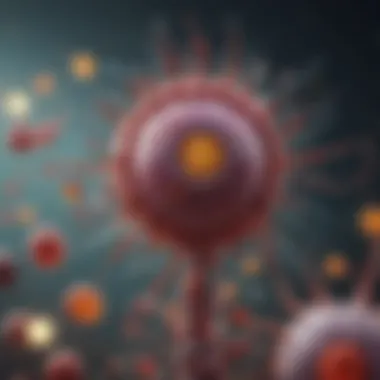Exploring the Multifaceted Impacts of Vaccination


Intro
Vaccination has become a cornerstone of modern healthcare, with profound implications for public health, society, and the economy. Understanding its impacts requires a comprehensive examination of various dimensions, ranging from the biological functions of vaccines to their societal perceptions and economic ramifications. The vaccination landscape is continually evolving, shaped by scientific advancements and social discourse.
In this article, we will explore how vaccines function at a cellular level, the extensive history of vaccination practices, and the controversies that accompany them. By synthesizing relevant research and public sentiment, we aim to clarify common misconceptions and convey the essential role of vaccinations in preventing disease.
This narrative will be beneficial for students, researchers, educators, and professionals keen to deepen their understanding of vaccination's effects.
Recent Advances
The field of vaccination is marked by rapid advancements that promise to enhance public health initiatives. From novel vaccine formulations to improved delivery mechanisms, these developments are pivotal in combating infectious diseases.
Latest Discoveries
Recent studies highlight the significance of mRNA technology in vaccine development, especially prominent during the COVID-19 pandemic. This approach allows for quicker responses to emerging infectious diseases. Research indicates that mRNA vaccines, such as those developed by Pfizer-BioNTech and Moderna, have demonstrated efficacy rates exceeding 90%.
Another area of investigation focuses on the benefits of booster shots. Research shows that booster doses can significantly increase immunity levels, particularly against variants of concern.
Technological Innovations
Innovations in vaccine delivery systems are making immunization more accessible. For instance, intranasal vaccines are being developed to provide easier administration, particularly for populations hesitant about injections. Technologies such as needle-free injection systems and micro-needles are expanding the potential for immunization in diverse settings.
Furthermore, digital tools are being utilized to track vaccination progress and manage records effectively. Blockchain technology, for instance, is being explored for maintaining secure, tamper-proof health data.
Myth Busting
Vaccines have been surrounded by numerous myths and misinformation. This section aims to address these misconceptions to promote greater understanding.
"Vaccination is safer than the diseases they prevent."
Common Misconceptions
- Vaccines cause the diseases they are meant to prevent.
- Natural immunity is always better than vaccine-induced immunity.
- Vaccines are linked to autism.
Each of these misconceptions can be addressed effectively with scientific evidence and research-backed communication.
Methodology
Examining the impacts of vaccination requires a structured approach to research and analysis. This methodology section outlines the processes involved.
Research Design
A mixed-methods approach is applied, integrating both quantitative and qualitative data. Scientific studies provide empirical evidence, while surveys capture public perception regarding vaccines.
Data Collection Techniques
Data collection involves systematic reviews of peer-reviewed articles, analysis of vaccination rates, and surveys that gauge public sentiment. Such comprehensive data is essential for forming conclusions and recommendations.
Understanding the intricate issues surrounding vaccination is crucial for informed public health policies. By incorporating diverse sources of information, we can pave the way for a more nuanced discourse surrounding vaccinations.
Preface to Vaccination
Vaccination plays a crucial role in public health, acting as a frontline defense against infectious diseases. Understanding vaccination is vital not only for healthcare professionals but also for the general populace. The knowledge surrounding vaccines impacts how diseases are managed and mitigated globally. This section will delve into the historical context of vaccination and explore various methodologies employed in vaccine development and administration.
Historical Context
The concept of vaccination dates back centuries. The first recorded use of a form of vaccination involved variolation, which was practiced in China around the 10th century. This method involved introducing material from smallpox sores to healthy individuals to confer immunity.
In the late 18th century, Edward Jenner conducted important experiments, leading to the development of the smallpox vaccine. His work laid the foundation for immunology. Following Jenner's advancements, vaccine development accelerated, targeting other diseases like rabies and tetanus.
The 20th century witnessed breakthroughs such as the polio vaccine developed by Jonas Salk, which drastically reduced polio incidence worldwide. Historical successes in vaccination underscore its significance in controlling epidemics and enhancing community health.
Vaccination Methodologies
Vaccination methodologies have evolved significantly over time. The current standard approaches involve live attenuated, inactivated, and subunit vaccines. Each method plays a distinct role in how immunity is generated.
- Live Attenuated Vaccines: These vaccines contain weakened forms of the virus or bacteria. They often elicit strong immune responses but may not be suitable for individuals with weakened immune systems.
- Inactivated Vaccines: Containing killed pathogens, these vaccines are safe for immunocompromised individuals, although they may require booster doses to maintain immunity.
- Subunit Vaccines: These vaccines use pieces of the pathogen, such as proteins, to stimulate an immune response without the risk of disease development.
Vaccination methodology influences not only individual immunity but also the broader public health landscape.


The continuous development of vaccine technology, including recombinant DNA technology and mRNA vaccines, reflects the ongoing quest for effective disease prevention strategies. An advanced understanding of these methodologies enables both healthcare providers and the public to navigate the complexities of vaccination confidently.
In summary, the historical context provides a backdrop for understanding why vaccines are pivotal to public health. The various methodologies showcase the clinical ingenuity behind vaccination, ultimately enhancing our ability to combat infectious diseases effectively.
Mechanism of Action
Understanding the mechanism of action of vaccines is crucial, not just for scientists and healthcare professionals but also for the general public. This section aims to clarify how vaccines interact with the immune system to provide protection against infectious diseases. By grasping these fundamental processes, individuals can better appreciate the significance of vaccination in maintaining public health. The mechanism of action encompasses the ways vaccines stimulate the immune system, the various types of vaccines, and their specific effects.
Immune Response Activation
Vaccines primarily function by activating the immune response. When a vaccine is administered, it introduces an antigen, which is a harmless component of the pathogen, into the body. This can be a weakened or inactivated form of the virus or bacteria, or a piece of its genetic material. The immune system recognizes this antigen as foreign, triggering a defensive response.
The immune response can be broken down into two main components:
- Humoral Immunity: This involves the production of antibodies by B cells. These antibodies are proteins that can specifically bind to the antigens of the invading pathogens. Once the immune system has produced antibodies against a specific pathogen, it can respond faster if exposed to that pathogen in the future.
- Cell-Mediated Immunity: T cells, another type of immune cell, are responsible for directly killing infected cells or helping B cells produce antibodies. They play a significant role in the long-term memory of the immune system, allowing for quicker and more effective responses to previously encountered pathogens.
Vaccination prepares the immune system to recognize and combat foreign invaders efficiently. By creating a memory of the pathogen without causing disease, vaccines enable the immune system to respond rapidly if it encounters the pathogen again.
Types of Vaccines
Vaccines can be categorized into several types based on their composition and the method used to elicit an immune response. Understanding these different types is essential, as each has distinct benefits and considerations:
- Inactivated or Killed Vaccines: These vaccines contain pathogens that have been killed or inactivated. An example is the polio vaccine. They often require multiple doses to achieve adequate immunity.
- Live Attenuated Vaccines: These vaccines use live pathogens that are weakened so they cannot cause disease. The measles, mumps, and rubella (MMR) vaccine is a common example. They tend to provide stronger and longer-lasting immunity but may not be suitable for everyone.
- Subunit, Recombinant, or Conjugate Vaccines: These vaccines include only parts of the pathogen, such as its proteins or sugars. The human papillomavirus (HPV) vaccine falls into this category. These vaccines are usually well-tolerated and can be effective without using live pathogens.
- mRNA Vaccines: A more recent advancement in vaccine technology, mRNA vaccines, such as the Pfizer-BioNTech COVID-19 vaccine, use synthetic messenger RNA to instruct cells to produce a viral protein, prompting an immune response without using live virus.
Vaccines are designed with various components to target specific diseases effectively and safely. The ongoing research in vaccine technologies continues to evolve, aiming to improve effectiveness and minimize side effects.
"The immune system's ability to remember and recognize specific pathogens is the cornerstone of effective vaccination, leading to long-lasting protection against diseases."
In summary, comprehending the mechanism of action of vaccines provides insight into their vital role in preventing infectious diseases. By stimulating the immune response through various methodologies, vaccines optimize our body’s defense mechanisms, ultimately leading to healthier populations.
Efficacy of Vaccines
The efficacy of vaccines is a crucial component in understanding their overall impact on public health. Vaccines not only protect individuals from infectious diseases but also have broader implications for community health. This section explores the evidence supporting vaccine effectiveness through rigorous clinical trials and the real-world data that highlights their benefits. Notably, this exploration addresses considerations such as population immunity, long-term outcomes, and the challenges in measuring efficacy against various strains of pathogens.
Clinical Trial Evidence
Randomized Controlled Trials
Randomized Controlled Trials (RCTs) are the gold standard in clinical research. Their design allows for the evaluation of vaccine efficacy in a controlled setting, eliminating confounding variables. By randomly assigning participants into either the vaccine or placebo group, RCTs effectively isolate the effects of the vaccine. This method yields high-quality evidence that can influence public health policies.
One key characteristic of RCTs is their ability to provide a clear causal relationship between vaccination and outcomes. For example, the clinical trials for the measles-mumps-rubella (MMR) vaccine have demonstrated strong efficacy in preventing these diseases, significantly contributing to childhood health. The controlled environment of RCTs minimizes bias, making them a reliable choice for evaluating vaccines.
However, while RCTs have many advantages, they also come with limitations. They often have strict inclusion and exclusion criteria, which may not fully represent the general population. This can affect the generalizability of the results to broader demographics, particularly in various age groups and those with pre-existing health conditions.
Longitudinal Studies
Longitudinal Studies focus on tracking outcomes over an extended period, providing insights into the long-term effectiveness of vaccines. This type of study is important as it assesses the sustained immune response post-vaccination. The key characteristic of longitudinal studies is that they observe the same population over time, allowing researchers to monitor how vaccine efficacy may change with emerging virus variants or waning immunity.
These studies are beneficial because they capture real-life scenarios and outcomes, unlike the more contained settings of RCTs. An example is the longitudinal study on the HPV vaccine, which has tracked its effectiveness in preventing cervical cancer over years, establishing its long-term benefits.
On the flip side, longitudinal studies can be resource-intensive and may face challenges like participant retention and time frames that can span many years. Still, they fill a critical gap by linking the vaccine with long-term health outcomes.
Real-World Effectiveness
Real-world effectiveness studies supplement clinical trial data by examining how vaccines perform in diverse populations under routine health care conditions. These studies are vital for understanding the practical implications of vaccination campaigns. For instance, post-marketing surveillance of the Pfizer-BioNTech COVID-19 vaccine showed high effectiveness in diverse community settings, reinforcing the findings from initial clinical trials.
The key point here is that while clinical trials provide essential data on vaccine efficacy, real-world effectiveness studies demonstrate that vaccines work under typical conditions. Factors such as community engagement and public education play significant roles in how vaccines perform once distributed widely. Understanding these dynamics is crucial for public health messaging and planning.
The continued assessment of vaccine efficacy and effectiveness is necessary for adapting public health strategies and ensuring community immunity against diseases.
Safety and Side Effects
Safety and side effects are crucial aspects of vaccinations that require in-depth examination. Understanding the safety of vaccines can help mitigate fears and misinformation surrounding them. This article aims to clarify potential side effects and their implications for public health. Vaccines, like any medical intervention, can cause reactions. Most of these reactions are mild and transient. However, a transparent discussion about both common reactions and rarer adverse events is essential for informed decision-making.
Common Reactions
Most individuals who receive vaccines experience minor side effects. These reactions typically occur within a few days after vaccination and usually resolve quickly. Common reactions might include:
- Redness at the injection site
- Mild fever
- Fatigue
- Headache
- Muscle soreness


These side effects indicate that the immune system is responding to the vaccine. It is important to emphasize that such reactions are generally mild and temporary. They help build a resilient immune response. Knowing these common reactions makes it easier for individuals to feel reassured about getting vaccinated.
Adverse Events
Vaccine-Associated Risks
Adverse events linked to vaccinations are rare. Vaccine-associated risks encompass severe allergic reactions or other unexpected events. These occurrences are critical to monitor, as they influence public trust in vaccination programs. The key characteristic of vaccine-associated risks is their rarity, especially when compared to the risks of the diseases the vaccines protect against. Understanding these risks contributes to the overall goal of ensuring that vaccines are safer, more effective, and widely accepted.
Unique features of vaccine-associated risks include:
- Rarity: Serious adverse events are infrequent.
- Monitoring: Continuous observation and studies help in identifying any new risks.
Despite their seriousness, the benefits of vaccination typically outweigh these risks by a substantial margin. Vaccines have proven to be a consistent choice for preventative medicine due to their effectiveness in controlling infectious diseases.
Monitoring and Reporting Mechanisms
Effective monitoring and reporting systems are vital for assessing vaccine safety. These mechanisms ensure that any adverse events are tracked and addressed promptly. One key aspect of monitoring is the Vaccine Adverse Event Reporting System (VAERS) in the United States, which collects data on adverse events after vaccination. This serves as an essential tool for health authorities.
The unique feature of monitoring and reporting mechanisms is their ability to integrate real-time data, thus allowing for timely responses. Benefits include:
- Transparency: Helps build public confidence in vaccination programs.
- Early Detection: Identifies patterns and potential problems early on.
However, these systems are not without their challenges. Misinterpretation of data can lead to public fear, creating unintended consequences on vaccine uptake.
"Vaccination is one of the safest and most effective ways to protect individuals and communities from infectious diseases."
Public Health Implications
Understanding the public health implications of vaccination is crucial in evaluating its role in disease prevention and health promotion. Vaccination is not simply a personal health decision; it is a communal endeavor with far-reaching effects on society as a whole. In this section, we will examine two important aspects: herd immunity and the impact of vaccination on disease incidence.
Herd Immunity
Herd immunity occurs when a significant percentage of a population becomes immune to a particular infectious disease, either through vaccination or previous infections. This phenomenon is vital for protecting individuals who cannot be vaccinated, such as infants or those with specific health conditions. When enough people in a community are vaccinated, the spread of the disease is significantly slowed or even halted.
The threshold for achieving herd immunity varies depending on the disease. For instance, measles requires about 95% of the population to be vaccinated to prevent outbreaks. Failing to meet this threshold can result in resurgence of diseases that were once under control. Furthermore, herd immunity can lead to indirect protection, benefiting those at risk by reducing their chances of exposure to the disease. This collective health benefit emphasizes the need for comprehensive vaccination programs and public health campaigns to encourage participation.
"Vaccination not only protects the individual, but it also safeguards the broader community, illustrating the interconnected nature of public health."
Impact on Disease Incidence
The impact of vaccination on disease incidence is profound. Vaccination programs have led to a drastic decline in the rates of many infectious diseases. For example, the introduction of the smallpox vaccine resulted in the complete eradication of the disease. This success story demonstrates the potential of vaccines to eliminate serious health threats.
In addition to eradication, vaccination also contributes to the reduction of morbidity and mortality associated with various diseases. For instance, the widespread use of the polio vaccine has led to a significant decrease in polio cases globally. This not only enhances individual health outcomes but also strengthens health systems by reducing the burden of disease on healthcare providers and resources.
Consider some key points regarding the impact of vaccination on disease incidence:
- Reduction in Disease Cases: Significant decreases in diseases such as measles, mumps, and rubella due to vaccination.
- Economic Benefits: Lower healthcare costs associated with treating vaccine-preventable diseases can free resources for other pressing health needs.
- Long-term Health Outcomes: By preventing diseases in childhood, vaccines can contribute to longer, healthier lives.
The implications of vaccination extend beyond personal health, influencing community health outcomes on a broader scale. Thus, fostering awareness about the importance of vaccination and ensuring easy access to vaccines is essential for promoting public health.
Societal and Cultural Perspectives
Understanding the societal and cultural perspectives on vaccination is crucial in this article. The implications of vaccination extend beyond health; they touch on societal values, beliefs, and trust in medical systems. This section aims to clarify how cultural attitudes and societal influences shape vaccination practices, which ultimately affect public health outcomes. Recognizing these factors is essential for addressing vaccination hesitancy and enhancing public health strategies.
Vaccination Hesitancy
Vaccination hesitancy refers to the reluctance or refusal to vaccinate despite the availability of vaccines. This phenomenon can stem from multiple sources, including parental fears, misinformation, or distrust in healthcare providers. Addressing vaccination hesitancy is key for improving vaccination rates.
Factors contributing to vaccination hesitancy include:
- Misinformation: The proliferation of inaccurate information on social media can create confusion regarding vaccine safety and efficacy.
- Distrust: Historical injustices in medical research may lead communities, particularly marginalized ones, to be skeptical of vaccines.
- Cultural beliefs: Some cultures may have inherent beliefs that oppose modern medicine or government interventions.
Educating communities about vaccines and addressing their concerns can help bridge the gap. Public health campaigns should be tailored to resonate with specific cultural contexts. When people see their concerns acknowledged and their values respected, they might be more inclined to vaccinate.
Cultural Beliefs Surrounding Vaccination
Cultural beliefs significantly impact vaccine acceptance. Cultures hold different views on health, illness, and medicine, which informs how they perceive and approach vaccination. Understanding these beliefs is vital for crafting effective health messaging.
Key cultural factors include:


- Traditional Medicine: Some cultures prioritize herbal or traditional remedies, viewing vaccines as unnecessary or harmful interventions.
- Religious Beliefs: Certain religious groups may hold convictions that contest the use of vaccines, prompting conflicts between medical advice and spiritual beliefs.
- Community Influence: In many cultures, individual choices are heavily influenced by communal consensus. If a community leader speaks against vaccination, it may deter others from seeking immunization.
"Cultural understanding is crucial when discussing vaccination. One-size-fits-all approaches may alienate communities rather than build trust."
To effectively address these cultural beliefs, public health initiatives must engage with community leaders and influencers. Open dialogues that respect cultural values can create a more conducive environment for vaccination advocacy. By recognizing the significance of both societal and cultural perspectives, we can begin to formulate strategies that foster broader acceptance of vaccines.
Global Vaccination Efforts
The topic of global vaccination efforts is pivotal in understanding how immunization practices can eradicate infectious diseases. Vaccination programs worldwide form the backbone of public health initiatives. They aim to safeguard populations, especially in regions where disease prevalence is high. By examining the existing programs, their approaches to outreach, and their successes and challenges, we can provide deeper insight into the collaborative global framework necessary for vaccination.
Vaccination Programs Worldwide
Vaccination programs are implemented across various countries, with each adapting to specific needs and circumstances. For instance, the World Health Organization (WHO) plays a crucial role in coordinating efforts and establishing guidelines. Some notable programs include the Expanded Programme on Immunization (EPI), which aims for universal childhood vaccination, and global campaigns for polio eradication.
Countries like India and Nigeria emphasize reaching remote populations, using mobile clinics and community health workers. Countries with robust health infrastructures, like the United States and Germany, often spearhead innovative vaccine development and distribution methods. These wide-ranging efforts demonstrate the global commitment towards maintaining public health through vaccination.
Challenges in Vaccine Distribution
Logistical Barriers
Logistical barriers pose a significant challenge in vaccine distribution, impacting the success of global vaccination efforts. These include transportation issues, inadequate cold chain management, and limited storage facilities. In some rural or conflict-affected areas, reaching the populations can be logistically complicated. A key characteristic of these barriers is their ability to disrupt timely vaccination, leading to outbreaks of vaccine-preventable diseases. It is essential to identify and analyze these logistical drawbacks to enhance vaccination programs.
"Effective logistics can ensure vaccines are stored and delivered at appropriate temperatures, preventing spoilage and ensuring efficacy."
The unique feature of logistical barriers is their variability depending on geographic and socio-economic conditions. While some regions may have well-established supply chains, others lack basic infrastructure, leading to inequitable access. Thus, focusing on improving logistical systems can greatly enhance vaccination coverage.
Policy and Regulatory Issues
Policy and regulatory issues represent another significant challenge to global vaccination efforts. These encompass national and international laws that govern vaccine approval, distribution, and administration. A key characteristic involves how policies are formulated and enforced, ensuring safety and public trust in vaccination programs.
In many cases, inconsistent regulations can hinder the rapid introduction of new vaccines, affecting public health outcomes. Moreover, debates about vaccine mandates or exemptions can create barriers to achieving high immunization rates. The unique feature of policy issues is their direct influence on the public's acceptance and participation in vaccination efforts.
Addressing these challenges involves evaluating existing policies, utilizing data to inform decisions, and developing frameworks that prioritize public health while respecting individual concerns. Understanding these policy dynamics can aid in optimizing vaccination strategies and ensuring equitable access for all populations.
In summary, global vaccination efforts are multifaceted, encompassing various programs and confronting significant challenges. Each aspect plays a crucial role in achieving public health goals worldwide.
Future Directions in Vaccination Research
Understanding future directions in vaccination research is crucial to developing effective public health strategies and responding to emerging infectious diseases.
Improvements in vaccination technology are essential in today’s world. With recent pandemics highlighting the urgency of rapid vaccine development, researchers and healthcare professionals need to invest in innovative strategies. The field looks towards refining existing vaccines and creating new ones. This section will explore key innovations and the concept of personalized vaccines.
Innovations in Vaccine Development
Vaccination development has evolved significantly over time. Modern techniques focus not just on traditional methods but also incorporate cutting-edge science. mRNA technology is a prime example of innovation in this area; it enables faster creation of vaccines. The Pfizer-BioNTech and Moderna COVID-19 vaccines showcased this shift, proving that rapid response to infectious threats is possible.
- Viral Vector Vaccines: These vaccines use a harmless virus to deliver important instructions to cells. This method can create a strong immune response and is already being used for other infections.
- Protein Subunit Vaccines: By using specific parts of the virus, protein subunit vaccines can be effective and safe. They stimulate an immune response without using live components of the pathogen.
- DNA Vaccines: These vaccines introduce DNA that codes for antigens directly into the host cells, initiating an immune response in a way that is often simpler than other methods.
These innovations demonstrate the dynamic nature of vaccine research and highlight the need for adaptability in response to infectious diseases.
Personalized Vaccines
Personalized vaccines represent a new frontier in vaccination, tailored specifically to an individual’s immune profile. This concept builds on the recognition that individuals react differently to vaccines based on various factors such as genetics, age, and pre-existing conditions.
Developing personalized vaccines can lead to more effective health outcomes. For example, certain cancers might be targeted using vaccines designed to provoke an immune response specifically linked to cancer cells in an individual patient. This targeted approach could minimize side effects and enhance effectiveness.
- Genetic Profiling and Biomarkers: Gathering genetic information helps researchers understand how different populations respond to vaccines.
- Tailored Immunization Strategies: Customizing vaccine types and schedules based on population segments, such as the elderly or those with specific health conditions, can improve overall vaccination success.
The future of personalized vaccines is promising, but significant challenges remain. Researchers must ensure safety, affordability, and accessibility of these tailored solutions. The path towards personalized vaccination, while complex, offers hope not only for individuals but also for public health at large.
End
Vaccination plays a pivotal role in public health, serving as one of the most effective means of controlling and preventing infectious diseases. This article has explored not just the biological efficacy of vaccines, but also their societal, cultural, and economic implications. Understanding the impacts of vaccination can enhance public knowledge and appreciation of its benefits, while also addressing concerns and misinformation prevalent in many communities.
Summary of Findings
The investigation into vaccination encompassed various dimensions. First, it was established that vaccines work by priming the immune system. This process activates immune responses that provide long-term protection against specific pathogens. Clinical trials and real-world studies affirm the significant efficacy of vaccines in reducing disease incidence. Moreover, safety profiles reveal that while common side effects may occur, severe adverse events are rare.
Public health implications include achieving herd immunity, which protects vulnerable populations. Vaccination hesitancy remains a challenge, influenced by cultural beliefs and misinformation. Global efforts to increase access to vaccines face logistical hurdles, calling for innovative strategies and policy reforms.
"Vaccination not only protects the individual but also fortifies community health through collective immunity."
The Path Forward
Looking to the future, continued research in vaccine development is crucial. Innovations such as mRNA technology have transformed the landscape of immunization. Personalized vaccines may further improve efficacy and safety profiles.
Continued public education is essential to mitigate hesitance. Engaging diverse communities and addressing cultural concerns will foster trust and improve vaccination rates. Finally, global collaboration is critical in overcoming distribution challenges and ensuring that vaccines reach those who need them the most. The ongoing evolution in vaccination science and practice suggests a promising future in the fight against infectious diseases.















